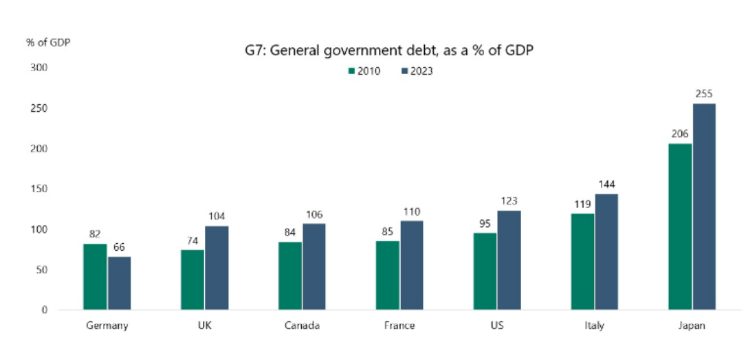The Federal Reserve seems to be on track to achieving its goal of a soft landing. Inflation is moving in the right direction, especially in the goods sector, and the economy now seems likely to avoid a recession. The Federal Reserve Bank of Philadelphia released its First Quarter 2024 Survey of Professional Forecasters on Feb. 9, 2024, projecting that real GDP will grow 2.4% in 2024, up 0.7 percentage point from the estimate in the previous survey. The forecast does not include a single quarter of negative economic growth, let alone a recession, just a soft landing. The following shows the survey’s mean probabilities of real GDP growth in 2024. It emphasizes the importance of thinking about forecasts not in terms of point estimates but as probabilities of a wide dispersion of possible outcomes (there are no clear crystal balls). With that in mind, the forecasters put the odds of a recession in 2024 as follows:
- 1st quarter: 17.3%
- 2nd quarter: 23.9%
- 3rd quarter: 25.6%
- 4th quarter: 25.2%
With the good economic news, the level of investor fears or stress, as measured by the VIX (an index representing the market’s expectations for volatility over the next 30 days), has been well below its historical average of about 20. However, it has been modestly rising since ending 2023 at 12.45. As I write this on Feb. 28, 2024, it was at 13.64 (though it reached 15.07 on Feb. 20). The rise indicates that investors are becoming somewhat more concerned about the outlook for the market. Historically, the VIX has been inversely related to the performance of the S&P 500—when the price of the VIX goes up, the price of the S&P 500 tends to go down.
There are good reasons for increasing investor fears. The geopolitical risks are high and rising, and other economic risks could lead to a “financial accident” that could negatively impact the stock and bond markets. Here is a list of concerns, any one of which could be problematic for markets. Before reading them, keep in mind that if I know these things, then so does the “market.” Thus, the information should already be in prices. Or, perhaps investors are just too optimistic, and FOMO keeps prices elevated. Please note that the list is not meant as a forecast (my crystal ball remains cloudy as always). It’s just a list of potential events and their risks to the markets.
- It will be difficult for the Fed to get inflation under control given the strong housing market (in terms of prices) because housing makes up 40% of the inflation basket. Housing prices are, in fact, rebounding. Thus, the risks are rising that the shelter components of inflation will stay elevated and complicate the Fed’s path back to its 2% target. In addition, the prices of services (such as homeowners and auto insurance and auto and home repairs) are rising at much faster rates, complicating the Fed’s task and increasing the risk that rates will have to remain higher for longer than the markets currently expect.
- Geopolitical tensions are high in Ukraine, the Middle East and China. China is particularly concerning. Add to these problems increasing nationalism, which could lead to trade wars and higher inflation, negatively impacting global economic growth.
- There is the threat of at least a partial shutdown of the U.S. government (let alone the risk of a default) because Congress cannot agree on spending bills.
- The U.S. debt-to-GDP ratio has now exceeded 100%. The empirical research, including the 2011 study “The Real Effects of Debt, the 2013 study “Does High Public Debt Consistently Stifle Economic Growth?”, the 2020 study “Debt and Growth: A Decade of Studies,” and the 2021 studies “The Impact of Public Debt on Economic Growth” and “Public Debt and Economic Growth: Panel Data Evidence for Asian Countries,” has found that debt at moderate levels can improve growth, but at high levels (thresholds somewhere between 75% and 100%) it can become damaging—if the high ratio isn’t addressed and becomes persistent, the debt becomes a drag on economic growth.
- There are continuing increases in sovereign debt in most developed nations and China. The U.S. is not the only country facing problems related to rising debt-to-GDP ratios. “Since 2010, that ratio has increased in all G7 countries except Germany.” Note in the chart below that all G7 countries except Germany now have ratios above 100%, a figure that not only hampers the government’s ability to address future financial crises but also constrains future growth. The rising debt problem is compounded by Europe’s need to significantly increase defense spending due to the ongoing war in Ukraine, with no end in sight. Rising ratios increase the risks of the eventual downgrade of sovereign debt—with accompanying problems for the financial markets. Defense spending also tends to be inflationary, as it doesn’t increase the supply of products consumers buy, yet pumps funds into the economy.

- With the Congressional Budget Office forecasting a $1.66 trillion deficit and a record $8.9 trillion of government debt maturing over the next year, the Treasury will have to find buyers for more than $10 trillion in U.S. government bonds in 2024—more than one-third of U.S. government debt outstanding and more than one-third of U.S. GDP. In addition, since September 2022 the Fed has been running down its balance sheet holdings by $95 billion a month (quantitative tightening or QT). The ability of the markets to absorb all that debt could be challenging, especially when the largest holders of Treasurys (foreigners) continue to decrease their ownership of U.S. government bonds. The risk is that rates could remain higher than the market currently expects. How will markets react if there is weak demand for Treasurys at a future auction?
- The work-from-home movement, leading to dramatic falls in office valuations, is already constraining bank lending and could lead to more bank failures.
- Municipal finances are coming under pressure in large cities (such as New York, Chicago and Los Angeles) due to the decline in property values of offices (leading to lower tax receipts) at the same time they face increasing expenses due to the surge in illegal immigration. Downgrades of debt ratings are possible if actions are not taken to address the trends. These problems could lead to lower spending by municipalities, negatively impacting the economy.
- For technology stocks, and especially the Magnificent 7, there seems to be an increasing risk of antitrust legislation that could negatively impact the sector—the one with the highest valuations.
What, if anything, should investors do with this information?
Takeaways
Investing in equities is always risky because of uncertainty about future returns, among a myriad of other reasons not to invest. That is why stocks have historically provided high returns—investors demand a large risk premium for accepting those risks. Thus, the first takeaway is that it is critical that you take into account the possibility of left tail events occurring—in the form of black swans (unforeseeable events, such as what happened on 9/11) or “white swans” (foreseeable risks like the ones mentioned above)—and that they are built into your investment plan, ensuring that you don’t take more risk than you have the ability, willingness or need to take.
The second takeaway is that if you are concerned about the aforementioned risks, you can do something about it. However, that should not include trying to time the market, which the evidence on the failure of active managers shows has been a loser’s game. Instead, you can reduce the risks of left tails by reducing your exposure to the economic cycle risks of traditional stocks and bonds and increasing your exposure to risks that don’t highly correlate with those same economic cycle risks.
A good example of an asset with unique risks is reinsurance, as hurricanes and earthquakes don’t (generally) cause bear markets and bear markets don’t cause hurricanes or earthquakes. This is a particularly good time to consider reinsurance, as markets have “hardened” due to a few years of poor returns (2017-19 and 2021). The result is that premiums have gone way up at the same time that underwriting standards have tightened and deductibles have risen (reducing risks). Funds that investors might consider for gaining exposure to this asset class include SRRIX, SHRIX and XILSX.
Another excellent example of assets with low correlation to traditional stocks and bonds is long-short (market neutral) factor funds, such as QSPRX and QRPRX.
Investors could also consider private, high quality, senior secured, floating-rate (avoiding the risk of inflation) credit, including funds such as CCLFX (with a net yield of about 12%).
It should be noted that each of these funds (with the exception of SHRIX) is an interval fund, providing limited quarterly liquidity (investors are compensated with higher expected returns for accepting that illiquidity risk).
Finally, investors could also consider trend-following strategies (such as QMHRX), which have historically performed well in extended bear markets.
The benefits of diversification are well known. In fact, it’s been called the only free lunch in investing. Adding unique risks is the most efficient and prudent way to reduce left tail risk. Investors who seek to benefit from diversification of the sources of risk and return of their portfolios must accept the fact that adding unique sources of risk means that their portfolio will inevitably experience what is called tracking error—a measure of the performance of a portfolio relative to the performance of a benchmark, such as the S&P 500.
“Tracking error regret” (which occurs when your diversified portfolio underperforms a broad market benchmark) raises its ugly head from time to time and can lead to the abandonment of even well-thought-out plans. But diversification is like portfolio “insurance” against having all your risk eggs in the wrong risk basket. It doesn’t eliminate the risk of losses or relatively poor returns, but it does reduce them. And diversification requires accepting the fact that parts of your portfolio will behave entirely differently than the portfolio itself and may underperform a broad market index (such as the S&P 500) for a long time. At least between these two choices (avoiding or accepting tracking error), there is no free lunch— you either have to accept tail risk or increase exposure to risk-free assets, such as one-month Treasury bills (and accept their very low real historical returns, even before considering taxes).
Larry Swedroe is head of financial and economic research for Buckingham Wealth Partners, collectively Buckingham Strategic Wealth, LLC and Buckingham Strategic Partners, LLC.
For informational and educational purposes and should not be construed as specific investment, accounting, legal, or tax advice. Certain information is based on third party data and may become outdated or otherwise superseded without notice. Third-party information is deemed reliable, but its accuracy and completeness cannot be guaranteed. The opinions expressed here are their own and may not accurately reflect those of Buckingham Strategic Wealth, LLC or Buckingham Strategic Partners, LLC, collectively Buckingham Wealth Partners. Neither the Securities and Exchange Commission (SEC) nor any other federal or state agency have approved, determined the accuracy, or confirmed the adequacy of this article. LSR-23-617

